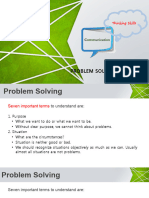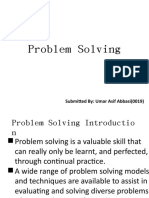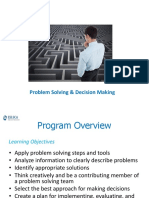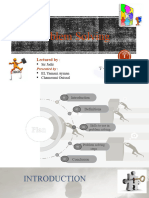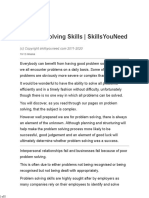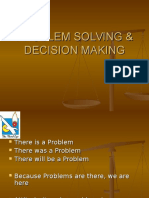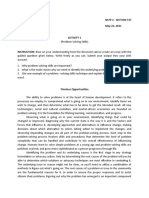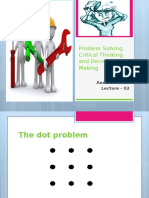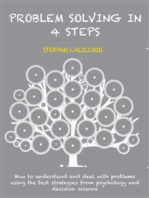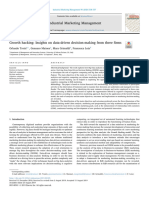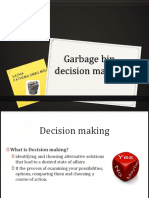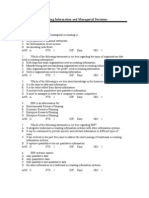Lecture 3
Uploaded by
supercellplayer221Lecture 3
Uploaded by
supercellplayer221PROBLEM SOLVING&
DECISION MAKING
SKILLS
BY DR
Lecture: 3
Instructor at the Egyptian Academy of
Engineering and Technology
- A review of the above
The scope of Problem-solving
Social problems
Political problems
Economic problems
Problem solving development
skills:
analysis
Synthesizing
Valuing
what is The Problem
A problem is a situation that confronts
an individual or group of individuals,
that requires resolution, and for which
the individual sees no apparent path to
obtaining the solution.
4
Characteristics of Problems
• Problems are problems only when we are aware
of them.
• A problem is a problem if you believe it to be one.
• Don't accept the original problem statement.
• Solutions often become problems.
• Problems and values change over time.
5
Concept of problem solving
•Problem solving is a process in which
we perceive and resolve a gap
between a present situation and a
desired goal, with the path to the goal
blocked by known or unknown
obstacles
6
Concept of problem solving
•It is a mental process in psychology and a
computational process in the field of
computer science. There are two different
types of problems, ill-defined and well-
defined problems: each with different
methods of solving.
7
Concept of problem solving
•problem solving in the field of psychology refers to
the process of finding solutions to the problems we
face in life. Solutions to these problems are usually
case- or context-specific. The process begins with
finding and formulating the problem, thus discovering
the problem and simplifying it. The next step is to
come up with possible solutions and then evaluate
those solutions. Finally, the solution is chosen to be
applied and validated.
8
Concept of problem solving
Problem solving has been defined as a
higher-level cognitive process and
mental function that requires further
adjustment and tuning of basic or
routine skills
9
Definitions of problem solving
• Problem solving is a set of
activities designed to Analyze a
situation systematically and
Generate, Implement, and
Evaluate solutions.
10
Concept of Decision making
•Decision making is a selection process
where one of two or more possible
solutions is chosen to reach a desired
goal
11
Concept of Decision making
In psychology, decision making is the
cognitive process resulting from
choosing a belief or action among
several possible possibilities. Each
decision-making process presents a
final choice, which may lead to action
and which may or may not prompt
action. 12
Concept of Decision making
Decision making is the process of
identifying and selecting alternatives
based on the values, preferences and
beliefs of the decision making.
13
Definitions of Decision making
Decision making is a mechanism
for making choices at each step
of the problem-solving process.
14
Problem-Solving vs. Decision-Making
Decision making is a part of
problem solving, and decision
making occurs at every step of
the problem-solving process
15
Problem-Solving vs. Decision-Making
Decision making is about
deciding what action to
take; it usually involves
choice between options.
16
Problem-Solving vs. Decision-Making
*The object of problem solving
is usually a solution, answer or
conclusion
17
Problem-Solving vs. Decision-Making
Most models of problem solving and decision
making include at least three phases:
*An Input phase in which a problem is perceived and an
attempt is made to understand the situation or problem;
*A Processing phase in which alternatives are generated
and evaluated and a solution is selected;
*A Review phase in which the solution is evaluated and
modifications are
made, if necessary
18
Problem-Solving vs. Decision-Making
Decision-making and problem-solving
skills are the basis for ensuring the success
of any organization. Problem-solving
skills can be categorized as strengths,
which in turn distinguish organizations
from each other and ensure their success
in overcoming obstacles. In addition to
giving flexibility in dealing with different
variables, and thus better ability to adapt
and succeed 19
Problem-Solving vs. Decision-Making
Problem-solving and decision-making is
the process of selecting a specific solution
from among two or more solutions
available in the work environment, and
ends with preferring an alternative from
among a number of alternatives or
solutions available to solve the problem,
and this is usually done after the person
who wants to make decisions is
identified. The problem and solutions or
alternatives to solve it.
20
Problem solving perspectives
Problem solving is usually looked at from
two perspectives.
*The first perspective is that there is only one
solution to the problem that is at hand.
Mathematical problems are a classic example of
such problems.
*The second perspective is problems that have
solutions that constantly change. These are
usually socio-emotional problems. For example,
your favorite color is a problem since it changes
almost every day and it might sometimes depend
on your mood 21
Problem solving process steps
Define the problem
Gather information
Develop alternatives
Weigh alternatives
Select the best alternative
Implement the solution
Monitor progress and follow up
22
DR
Instructor at the Egyptian Academy of Engineering and
Technology 23
You might also like
- W9 - Problem Solving and Decision MakingNo ratings yetW9 - Problem Solving and Decision Making22 pages
- Problem Solving: Submitted By: Umar Asif Abbasi (0019)No ratings yetProblem Solving: Submitted By: Umar Asif Abbasi (0019)11 pages
- Training (Problem Solving - Decision Making)No ratings yetTraining (Problem Solving - Decision Making)88 pages
- Problem Solving Powerpoint Content 1228245399176897 8No ratings yetProblem Solving Powerpoint Content 1228245399176897 813 pages
- Lecture 3 - 4 PROBLEM SOLVING Final 26032023 104927pmNo ratings yetLecture 3 - 4 PROBLEM SOLVING Final 26032023 104927pm53 pages
- Practicum Problem Solving Report Final PDFNo ratings yetPracticum Problem Solving Report Final PDF19 pages
- Assist Clients With Policy Development ToNo ratings yetAssist Clients With Policy Development To10 pages
- Problem Solving Skills skillsYouNeed PDFNo ratings yetProblem Solving Skills skillsYouNeed PDF8 pages
- Problem Solving & Decision Making at NTPCNo ratings yetProblem Solving & Decision Making at NTPC32 pages
- Creative_Problem_Solving_for_Managers_Developing_S..._----_(4._Problem_Solving_and_Improvisation) (1)No ratings yetCreative_Problem_Solving_for_Managers_Developing_S..._----_(4._Problem_Solving_and_Improvisation) (1)42 pages
- CU-FYUGP_2nd Semester_Science of Mental Processes_Module 2No ratings yetCU-FYUGP_2nd Semester_Science of Mental Processes_Module 210 pages
- 19.12.2022 Problem Solving & Decision Making by DR - Kashif Firaz AhmadNo ratings yet19.12.2022 Problem Solving & Decision Making by DR - Kashif Firaz Ahmad68 pages
- Chapter 11 Problem Solving and CreativityNo ratings yetChapter 11 Problem Solving and Creativity33 pages
- Problem Solving and Critical Thinking SkillsNo ratings yetProblem Solving and Critical Thinking Skills38 pages
- Problem Solving, Critical Thinking and Decision Making100% (1)Problem Solving, Critical Thinking and Decision Making49 pages
- Problem Solving & Decision Making: Skills Improvement ProgramNo ratings yetProblem Solving & Decision Making: Skills Improvement Program32 pages
- Problem solving in 4 steps: How to understand and deal with problems using the best strategies from psychology and decision scienceFrom EverandProblem solving in 4 steps: How to understand and deal with problems using the best strategies from psychology and decision scienceNo ratings yet
- Notes Community Mobilization Skills Level 5 201883% (6)Notes Community Mobilization Skills Level 5 201812 pages
- Creative Thinking and Problem Solving WorkbookNo ratings yetCreative Thinking and Problem Solving Workbook8 pages
- Vision VAM 2020 (Ethics) Guide To Handle Case StudiesNo ratings yetVision VAM 2020 (Ethics) Guide To Handle Case Studies21 pages
- CAPS FET - MATHEMATICAL LITERACY - GR 10-12 - Web - DDA9 PDF80% (5)CAPS FET - MATHEMATICAL LITERACY - GR 10-12 - Web - DDA9 PDF134 pages
- A Review and Assessment of Land-Use Change ModelsNo ratings yetA Review and Assessment of Land-Use Change Models90 pages
- Introduction To Business Analytics: Insights and Learnings: University of Eastern PangasinanNo ratings yetIntroduction To Business Analytics: Insights and Learnings: University of Eastern Pangasinan1 page
- Growth Hacking, Insights On Data-DrivenNo ratings yetGrowth Hacking, Insights On Data-Driven20 pages
- SFM Ch.1 Introduction To Strategy and Financial Mgmt.No ratings yetSFM Ch.1 Introduction To Strategy and Financial Mgmt.7 pages
- ABCs of Relationship Selling Through Service 6Th Canadian Edition by Charles M. Futrell - Test BankNo ratings yetABCs of Relationship Selling Through Service 6Th Canadian Edition by Charles M. Futrell - Test Bank37 pages
- 2.3 Cognition - Orientation, Attention, Memory, Delirium and LearningNo ratings yet2.3 Cognition - Orientation, Attention, Memory, Delirium and Learning20 pages
- The Effects of Peer Pressure and Their Academic Performance To The Senior High School Students of Juan Villablanca Memorial High School0% (1)The Effects of Peer Pressure and Their Academic Performance To The Senior High School Students of Juan Villablanca Memorial High School8 pages
- Decision-Making Under Certainty: Planning Self-Instructional Material 65100% (1)Decision-Making Under Certainty: Planning Self-Instructional Material 652 pages
- Industrial Marketing Hawaldar For Test Only Chap1 2 3 4 6 7100% (1)Industrial Marketing Hawaldar For Test Only Chap1 2 3 4 6 7166 pages
- Behavioral Finance Vs Traditional Finance: January 2009No ratings yetBehavioral Finance Vs Traditional Finance: January 200911 pages



